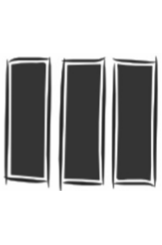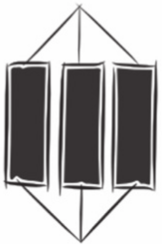Having a fancy structure and neat lists of skills is all well and good, but we’re edging pretty close to some kind of weird commune where we all just float around collaborating with our fellow global citizens. For a curriculum to be effective, it needs rigour – and for that, we need something concrete from which to build.
Along with the learning and thinking skills, we’ve also got subject-specific skills to contend with. These skills are an essential part of the work we do with our children; again, if we’re not extremely careful, they’re really easy to miss. Quite often in curriculum documents, the subject-specific skills are either not made explicit or, worse, they’re buried under the weight of content that has to be delivered.
Making the decision to approach the content of the curriculum with much more flexibility meant that having a clear approach to the development of these subject-specific skills became essential. First up, we had to find them. In the olden days, we used to have a skills document. This usually took the form of a series of grids that outlined exactly what skills our children would need to develop in order to be scientists, historians, geographers, designers and so on.
In history, for example, the skills we want the children to develop are applicable to any time period they are exloring, such as ‘Recognise and interpret primary and secondary sources’ (Year 6). This is an enquiry skill, and having a clear understanding of how this can be broken down and developed across each year group is incredibly helpful.
Let’s start with the following objective: We are learning about Roman political life. There’s nothing necessarily wrong with this, but if we use it as it stands we’re limiting our options. If we’re doing the Romans, then knowing about Roman political life is important. If we’re interested in being more sophisticated in our approach than just telling the pupils what they need to know, then we can view the knowledge as the outcome, rather than the learning.
Here’s where knowledge and skills become intertwined. We want the children to know about the Romans (or Roman political life), but we also want them to learn about it whilst developing a useful skill (the ‘what’ and the ‘how’ we looked at earlier), so: We are learning to recognise and interpret primary sources to help us find out about Roman political life. We can’t learn, develop or practise this skill without applying it to a piece of knowledge, and if we attempt to teach children the knowledge without bothering with the skill, then we’re reducing history, or anything else for that matter, to nothing more than a body of facts to be remembered.
Using existing documents and anything else we could find, it didn’t take long to create skills progression grids across the whole curriculum. They started at Year 1 and clearly demonstrated the development of skills through to Year 6. To make the progression as clear as possible, we weren’t just interested in what this would look like from one year group to the next; we also wanted to know what progression would look like within a year group. To help with this we used the SOLO taxonomy.
SOLO stands for Structure of Observed Learning Outcomes and is a model that describes levels of increasing complexity in understanding. It was devised by John Biggs and Kevin Collis in the 1980s and has been used in various different ways since then.1 It became quite popular a few years ago with lots of secondary teachers as a means of making the process of learning more explicit within lessons, but then seemed to fall out of favour pretty quickly following the realisation that the time spent getting the children to understand the various stages might be better spent just teaching them important stuff.
Despite the criticism, I’ve always believed that it’s not necessarily what you’ve got but what you do with it that counts, and whilst I’m not particularly interested in spending time teaching the stages of the taxonomy to the children, it does have an extremely useful application in terms of supporting the structure of skills progression.
The taxonomy breaks down learning into five levels:2
Prestructural: The pupil hasn’t fully understood the point and can only give a very basic response.
Unistructural: The pupil’s response focuses on just one relevant aspect.
Multistructural: The pupil’s response focuses on several relevant aspects.
Relational: The different aspects have become integrated into a coherent whole.
Extended abstract: The whole may become conceptualised at a higher level of abstraction and generalised to a new topic or area.
This all sounds very clever. Quite often this is not a good thing – there is a lot to be said for keeping everything as straightforward as possible. In this case, though, I think the cleverness translates very well into something that is of practical use – the beginnings of a clear focus for curriculum planning.
If we take the Year 6 skill we looked at above, ‘recognise and interpret primary sources’, there’s the risk that, even if we do make it our focus, it could still fall victim to being ‘covered’ and ticked off. We’ll explore the process of learning in Part II, but one of the most important shifts in our collective thinking as teachers has been in our understanding that learning happens over time rather than in a single lesson. We could just return to the objective and repeat it over the course of the topic. This would help with the learning (and the retention of learning) side of things, but not so much with the children’s depth of understanding. For this, we need the helpful set of verbs that come with each SOLO level.
The three levels that we were most interested in were multistructural, relational and extended abstract. I don’t fully understand why prestructural exists as a level – maybe it’s for the sake of completion, but I don’t think there will be many teachers out there who aim for children to be happily tootling along in blissful ignorance. I feel the same about unistructural. If we’ve decided to work across a whole term, then we can’t (and definitely shouldn’t) get away with the children just knowing or being able to do a few things. If we’re aiming for greater depth, it’s got to be our intention to build a significant body of knowledge and skills. We need to make the most out of the space and time we’ve got.
The SOLO taxonomy only really gets going when we hit the multistructural stage, where the pupils’ responses focus on several (ideally lots) of relevant aspects. This felt like a decent entry point for building the ‘in-year’ progression we were after. After some experimentation, here’s what it looked like for the history skill we considered earlier:
|
Multistructural
|
|
|
Relational
|
|
|
Extended abstract
|
|
There’s definite progression here. As a teacher, you’ve got somewhere to go with it all. It also helps with sequencing. Imagine jumping in and attempting to teach children how to generalise as a skill without having made sure that there was a significant body of knowledge in place first. It wouldn’t make any sense. Generalise sits where it does for a reason. Interpret (making sense of the words within the historical source – understanding the content) and analyse (looking at the source methodically and in detail) both allow the children to build knowledge. When we’re happy that this has happened, then we can think about skills like generalising.
Another point worth noting is that whilst there are three boxes above, this doesn’t equate to three lessons. Furthermore, whilst the taxonomy might represent increasing complexity, it definitely doesn’t represent a hierarchy of importance. The skills of interpreting and analysing are every bit as important as generalising, and we might actually spend quite a lot of time on the first two before looking at developing anything else. Regardless of how long we might spend working on each aspect, the overall aim should be for all the children to have an opportunity to work at the extended abstract stage.
Along with the obvious benefits for our children, this does an important job for us too. Having a solid foundation gives you confidence, and it’s much easier to take risks (and to justify them) if you know you’ve got something backing you up. At some point, if you do decide to do things differently, you’ll find yourself in a situation in which someone will ask you what you’re up to and why. And when the questions come, you need to be able to look them squarely in the eye and let them have it:
Our curriculum is skills based and knowledge rich; we cover less because we believe that our children should have the opportunity to study areas of the curriculum in greater depth. We want our children to produce exceptional outcomes whilst developing their independence, curiosity and creativity. We want to produce collaborators, innovators, leaders and, more than anything else, young people who understand what it means to be human.
Perfect. Now all we’ve got to do is put it into practice.
1 J. Biggs and K. Collis, Evaluating the Quality of Learning: The SOLO Taxonomy (New York: Academic Press, 1982).


